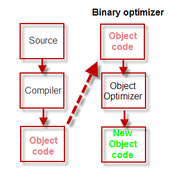- Object code optimizer
-
An object code optimizer, sometimes also known as a post pass optimizer or, for small sections of code, peephole optimizer, takes the output from a source language compile step - the object code or binary file - and tries to replace identifiable sections of the code with replacement code that is more algorithmically efficient (usually improved speed).
Contents
Examples
- The "COBOL Optimizer" developed by Capex Corporation in the mid 1970's for COBOL. This type of optimizer depended, in this case, upon knowledge of 'weaknesses' in the standard IBM COBOL compiler, and actually replaced (or patched) sections of the object code with more efficient code. The replacement code might replace a linear table lookup with a binary search for example or sometimes simply replace a relatively 'slow' instruction with a known faster one that was otherwise functionally equivalent within its context. This technique is now known as "Strength reduction". For example on the IBM/360 hardware the CLI instruction was, depending on the particular model, between twice and 5 times as fast as a CLC instruction for single byte comparisons.[1][2]
Advantages
The main advantage of this method was that the stock of already compiled customer programs (object code) could be improved almost 'instantly' with minimum effort, reducing CPU resources at a fixed cost (the price of the proprietary software). A disadvantage was that new releases of COBOL, for example, would require (charged) maintenance to the optimizer to cater for possibly changed internal COBOL algorithms. However, since new releases of COBOL compilers frequently coincided with hardware upgrades, the faster hardware would usually more than compensate for the application programs reverting to their pre-optimized versions (until a supporting optimizer was released).
Other optimizers using the same concept
Some binary optimizers seek to reduce only the size of binary files by eliminating duplicate library modules - without necessarily also improving their performance, while others utilize run-time metrics to introspectively improve performance using techniques similar to JIT compilers.
Recent developments
More recently developed 'binary optimizers' for various platforms, some claiming novelty but, nevertheless, essentially using the same (or similar) techniques described above, include:-
- The Sun Studio Binary Code Optimizer [1] - which requires a profile phase beforehand
- Design and Engineering of a Dynamic Binary Optimizer - from IBM T. J. Watson Res. Center (Feb 2005) [2] [3]
- QuaC: Binary Optimization for Fast Runtime Code Generation in C [4] - (which appears to include some elements of JIT)
- The Rio project [5]
- COBRA: An Adaptive Runtime Binary Optimization Framework for Multithreaded Applications [6]
- Spike Executable Optimizer (Unix kernal) [7]
- "SOLAR" Software Optimization at Link-time And Run-time
References
Categories:- Compiler optimizations
- Computer performance
- Software optimization
Wikimedia Foundation. 2010.

